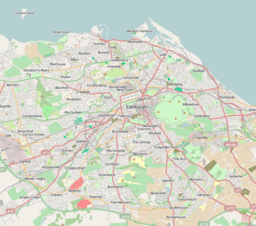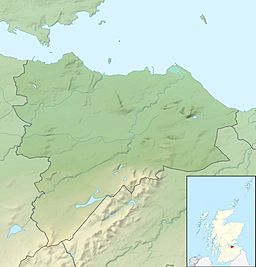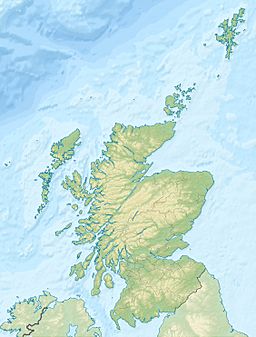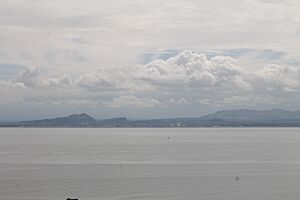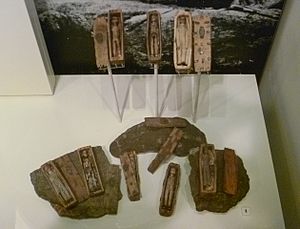Arthur's Seat facts for kids
Quick facts for kids Arthur's Seat |
|
|---|---|
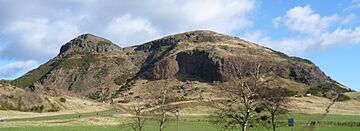 |
|
| Highest point | |
| Elevation | 251 m (823 ft) |
| Prominence | c. 186 m (610 ft) |
| Listing | Marilyn |
| Geography | |
| Location | Edinburgh, Scotland |
| OS grid | NT27537295 |
| Topo map | OS Landranger 66 |
| Climbing | |
| Easiest route | hillwalking |
Arthur's Seat is an ancient, extinct volcano in Edinburgh, Scotland. It is the main hill in a group that makes up most of Holyrood Park. The famous writer Robert Louis Stevenson once called it "a hill for magnitude, a mountain in virtue of its bold design."
This impressive hill is just east of Edinburgh's city centre, about 1 mile (1.6 km) from Edinburgh Castle. It stands tall above the city, reaching a height of about 251 metres (823 feet). From the top, you can see amazing views of Edinburgh and the areas around it. It's quite easy to climb and is a popular spot for hillwalking. You can climb it from almost any direction. The easiest way up is from the east, where a grassy slope rises above Dunsapie Loch.
A part of the hill called Salisbury Crags used to be a popular place for rock climbing. However, climbing there has been stopped since 2019 for safety reasons.
Contents
What's in a Name?
Some people believe the name "Arthur's Seat" comes from old legends about King Arthur. There are other hills in Britain with similar names, like Ben Arthur (also known as The Cobbler) in Scotland and Arthur's Chair in the English Lake District. This might suggest a connection to the legendary king.
How Arthur's Seat Was Formed
Arthur's Seat is part of a special area called the Arthur's Seat Volcano site of special scientific interest. This area is protected because of its important geology, unique grassland, and rare plants and animals.
Just like the rock under Edinburgh Castle, Arthur's Seat was formed by a volcano a very long time ago. This happened during the early Carboniferous period, about 341 to 335 million years ago. Later, a huge glacier moved across the land from west to east. This glacier wore away the softer rock, leaving behind the hard volcanic rock. This is why you see rocky crags on the west side and a tail of material swept to the east. The Salisbury Crags, which are basalt cliffs, were formed this way.
From some angles, Arthur's Seat looks like a sleeping lion. Two of its old volcanic vents are even called the 'Lion's Head' and the 'Lion's Haunch'.
Arthur's Seat and the nearby Salisbury Crags were very important for understanding how our planet works. A scientist named James Hutton studied these rocks. He realized that sedimentary rocks (formed from layers of sediment) and igneous rocks (formed from cooled lava) were created at different times and in different ways than people thought back then. You can even see a place called Hutton's Section in the Salisbury Crags. Here, you can see where hot magma pushed through older sedimentary rocks to form new rock layers.
A Look at Human History
People have lived around Arthur's Seat for a very long time. There are remains of an ancient hill fort on the very top of Arthur's Seat and on a smaller hill nearby called Crow Hill.
You can also see old fort defences around the main part of Arthur's Seat, especially at Dunsapie Hill and above Samson's Ribs. These forts are very old, from prehistoric times. They were likely important places for the Votadini people, who lived around 600 AD. On the east side of the hill, two stony banks are what's left of an Iron Age hill-fort. You can also see old farming terraces above the road, especially from Duddingston.
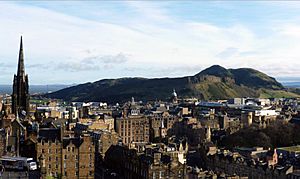
In 1590, a large bonfire was lit on the Salisbury Crags. This was to celebrate the safe return of James VI of Scotland and Anne of Denmark.
A path that goes along the top of the slope under Salisbury Crags has been a popular walk for a long time. It offers great views of the city. This path became known as the Radical Road. It was paved in 1820, after a time of unrest, to give work to people who had lost their jobs. This route has been closed since 2018 because rocks fell from the cliffs above.
In 1836, five boys looking for rabbits found something very mysterious: 17 tiny coffins with small wooden figures inside. They were found in a cave on the crags of Arthur's Seat. No one knows for sure why they were made. Some people thought they were for witchcraft. More recently, it has been suggested they might be connected to a famous historical crime that happened in Edinburgh in 1828. The surviving coffins are now on display at the National Museum of Scotland in Edinburgh.
Arthur's Seat is also important to the history of the Church of Jesus Christ of Latter-day Saints. In 1840, Scotland was dedicated here for the preaching of their gospel. An important leader, Orson Pratt, climbed the hill in 1850 to pray for more people to join the church.
In 1884, a famous mountain guide named Emile Rey visited Edinburgh. He climbed Arthur's Seat, and local stories say he thought it would take him most of the day to reach the top!
Myths and Legends
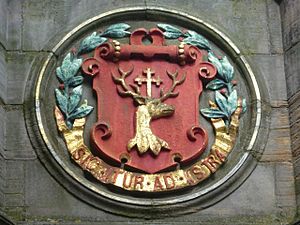
Arthur's Seat is often thought to be one of the possible locations for Camelot. This was the legendary castle and court of the famous warrior-chief, King Arthur.
Another old story says that Scotland's 12th-century king, David I, was hunting at the foot of Arthur's Seat. He fell from his horse and was about to be attacked by a stag. But then, he saw a vision of a cross between the animal's antlers. The stag then strangely turned away, leaving him safe. David believed his life was saved by a miracle. Because of this, he founded Holyrood Abbey on that very spot. The old symbol for the nearby area of Canongate even shows a stag's head with a cross between its antlers.
The slopes of the hill facing Holyrood are also famous for a tradition. Young girls in Edinburgh traditionally wash their faces in the dew on May Day. They believe this will make them more beautiful. A poem from 1773 by Robert Fergusson mentions this tradition:
On May-day, in a fairy ring,
We've seen them round St Anthon's spring,
Frae grass the caller dew draps wring
To weet their een,
And water clear as crystal spring
To synd them clean
Arthur's Seat in Books and Movies
Arthur's Seat has appeared in many stories and films:
- It's mentioned in The Scottish Chiefs, a book by Jane Porter published in 1921.
- In James Hogg's 1824 novel The Private Memoirs and Confessions of a Justified Sinner, two brothers get lost in a fog on Arthur's Seat. They see strange things, and one brother almost harms the other.
- Sir Walter Scott wrote in 1829 that he used to roam the "solitary and romantic environs" of Arthur's Seat as a schoolboy. He would tell stories of knights and magic with a friend.
- Mary Shelley's famous novel Frankenstein also mentions Arthur's Seat as one of Edinburgh's sights.
- The 2009 novel One Day by David Nicholls starts and ends with the main characters climbing Arthur's Seat. The 2011 film and the 2024 TV series based on the book also show scenes on the hill.
- In Jules Verne's novel The Underground City, a young girl named Nell sees her first sunrise from Arthur's Seat. She had never been above ground before.
- In Catherine Sinclair's Holiday House, children climb Arthur's Seat. They misbehave on the way down, and one child almost falls off a cliff.
- Arthur's Seat is featured in several novels by Scottish writer Ian Rankin.
- In Stephen Baxter's novel Moonseed, the volcano becomes active again and destroys Edinburgh.
- The mystery of the 17 coffins found on Arthur's Seat is the subject of Philip Caveney's 2014 teen novel Seventeen Coffins.
- In Julian May's Galactic Milieu series, Arthur's Seat is an important location.
- In Z. Rex, part of Steve Cole's The Hunting trilogy, Arthur's Seat is the first place the characters land in Scotland.
- In the 2017 film T2 Trainspotting, characters played by Ewan McGregor and Ewen Bremner run up the hill.
- Arthur's Seat also appears in the 2018 video game Forza Horizon 4.
See also
 In Spanish: Arthur's Seat para niños
In Spanish: Arthur's Seat para niños


